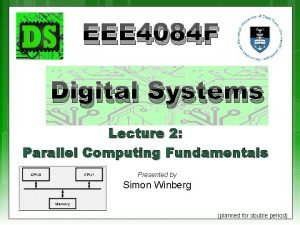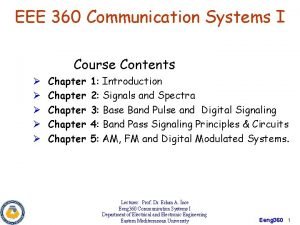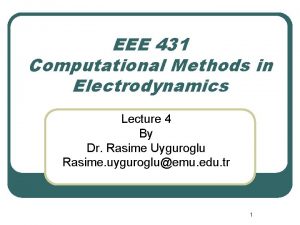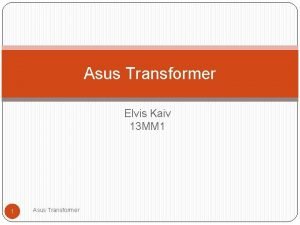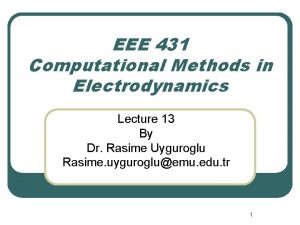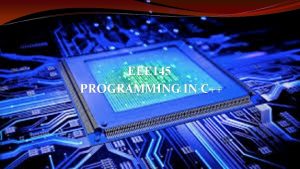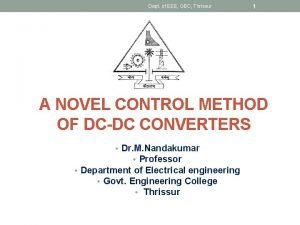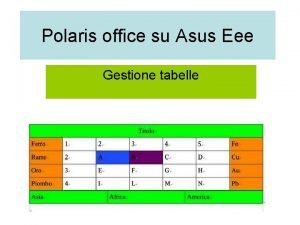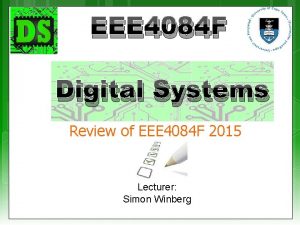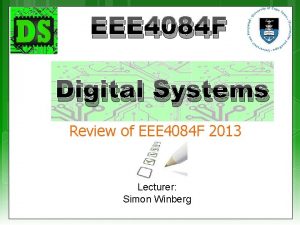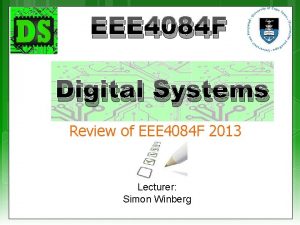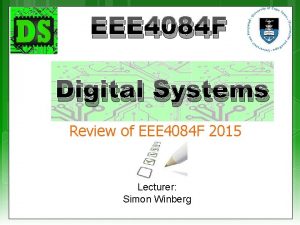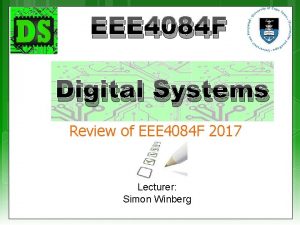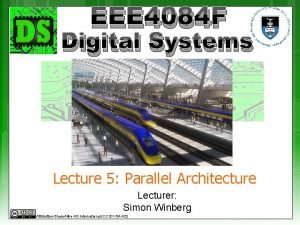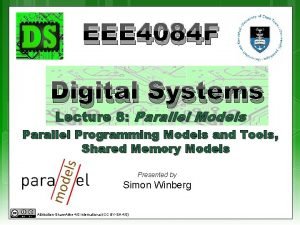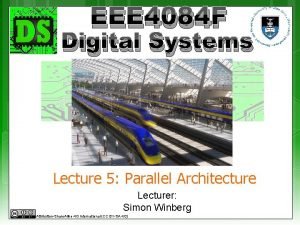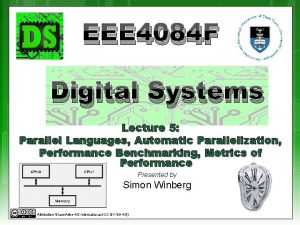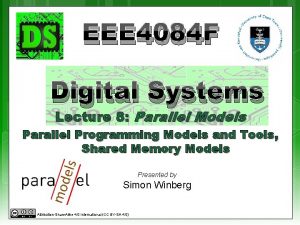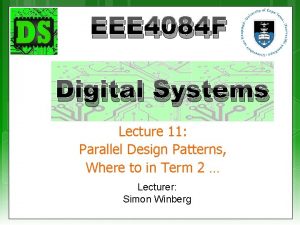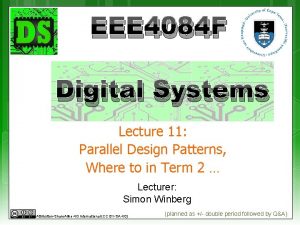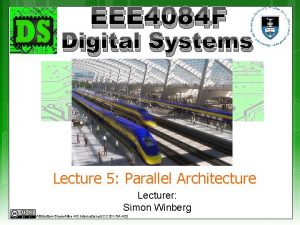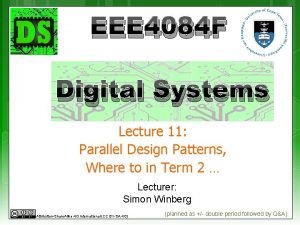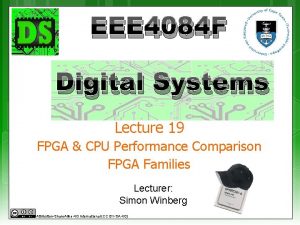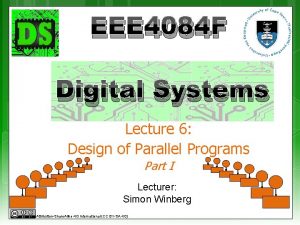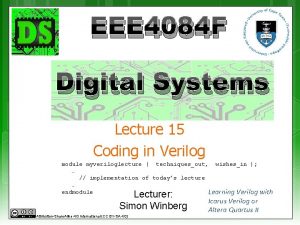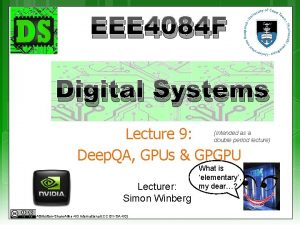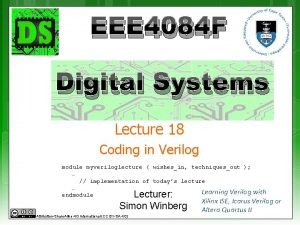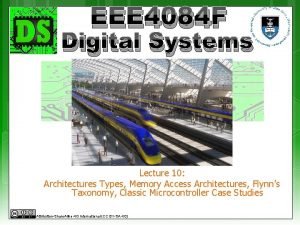EEE 4084 F Digital Systems Lecture 2 Parallel



![Quiz 0 review: Q 1 How good is your VHDL? (tick answer) [1] None Quiz 0 review: Q 1 How good is your VHDL? (tick answer) [1] None](https://slidetodoc.com/presentation_image_h/2b6911a0dcac1009b33322665ab03152/image-4.jpg)

































- Slides: 37

EEE 4084 F Digital Systems Lecture 2: Parallel Computing Fundamentals Presented by Simon Winberg (planned for double period)

Lecture Overview Review of quiz 0 UML blurb Parallel computing fundamentals Automatic parallelism Performance benchmarking Trends

Quiz 0 Review… 29 students wrote the quiz
![Quiz 0 review Q 1 How good is your VHDL tick answer 1 None Quiz 0 review: Q 1 How good is your VHDL? (tick answer) [1] None](https://slidetodoc.com/presentation_image_h/2b6911a0dcac1009b33322665ab03152/image-4.jpg)
Quiz 0 review: Q 1 How good is your VHDL? (tick answer) [1] None [2] A little [3] Reasonably good [4] Excellent None: 0% A little Excellent: 0% 11% Reasonably good 89% 3% 17% 1 - not used 2 - A little 3 - Reasonably 4 - Excellent This year 2013 79% 2012

Quiz 0 review: Q 2 (2012) Q 2 Briefly motivate why computer engineers, planning to work on large and complex FPGA projects, should understand both Verilog and VHDL. Bla. Starts Myinteresting, thoughts…but how relevant is this to the question? Sounds pretty good My thoughts…

Quiz 0 review: Q 2 Briefly motivate why computer engineers, planning to work on large and complex FPGA projects, should understand both Verilog and VHDL. Now you’re talking big savings & benefits Answer: The main reason is reuse. Reusing existing gateware devices. For example, there might be an excellent digital filter out there on the web (e. g. opencores) that does almost what you want; but it’s in Verilog instead of your favorite VHDL. So you have to either start from scratch or learn Verilog.

Quiz 0 review: Q 3 Have you used Altera Quartus II? Or Xilinx ISE? Check appropriate boxes. Question 3: Quartus II exc Experience e llen t 11 A 5 little Question 3: Xilinx ISE Experience 2014 A little 1 None A Little Reasonably Good Not used Excellent 20 Excellent 23 Reasonably good (i. e. almost everyone has used it) 3% 1 - not used 21% 2013 76% 3% 10% 2 - A little 3 Reasonably 4 - Excellent 2012 86% 2013

Quiz 0 review: Q 4 Close! But no cigar More ‘intelligence’? ! My cellphone is probably as intelligent as my My thoughts? . . . PC… as in not at all intelligent based on the turning test. Heading into troubled waters here

Quiz 0 review: Q 4 Not precisely… That’s a special case Pretty good, if a bit wordy I’d be happy with something clear & general. E. g. : It is a computer. Suggested that is able to perform sample answer…multiple computations in parallel.

Quiz 0 review: Q 5 The story seems on the right track; don’t really find it all that clear. My thoughts on the topic: high performance computers are becoming more task-specific – the trend is moving away from supercomputers for general applications, towards platforms that are more Mytailored) thoughts… custom-designed (or to a particular domain of application (or even to a specific application – e. g. , reconfigurable computing platforms).

Question 6 Good: HPC system can be in the form of an embedded system: its special purpose, must be fast, real-time, and perform tasks concurrently. An HPC with a well defined task can be optimised for that task - hence akin to an embedded system. Bad: An embedded system can be very complex, such as a HPC placed into a bigger system, still making it embedded. HPCs are trending towards embedded systems because they are becoming more task specific. To enhance performance and increase functionality (? )

Quiz 0 review: Q 6 In computer engineering terminology, what is meant by sampling? Include a short example and possibly a image to aid your explanation. ! ! od A student’s answer… o g tty e Pr my description …

Quiz 0 review: Q 6 In computer engineering terminology, what is meant by sampling? Include a short example and possibly a image to aid your explanation. Sampling, used by computer engineers, typically refers to the process of digitizing an analogue signal, or looking at discrete instances of a continuous signal. A sample is basically a value or set of related values representing an instance in time of an analogue/real event. Usually a fixed sample period is used. a sample Analogue / real signal time sample period

UML Review* General errors that student often make: Not using the UML syntax (at all) Block and line models, things like flowcharts Using the UML syntax wrongly Invalid modelling constructs (i. e. , wrong type of connectors / associations and blocks) Vague models Insufficient information Some examples of common mistakes… * No longer a UML assessment in Quiz 0 due to time constraints

UML demonstration Look at this if your UML understanding is lacking. Task: Produce a UML model describing the products and people related to Joe Baggits, according to the description below. JOE'S STORY: Joe Baggits is a developer in the Construction Division of Freezit Commerial Products (FCP) Pty. Ltd. The FCP corporation produces a variety of Cooling systems, grouped into two product ranges, namely: 1) the portafrige range and 2) the coolzone range. The portafrige range includes the Icecart™ and the Chillblock™. Coolzone range includes the Shop. Frige™ and Coolroom™. Andy Wrapp is also a developer in the Construction Division and is Joe's manager. Joe works on portafridge products, whereas Andy works on coolzone products.

Sample Solution Notice use of roles, aggregation and inheritance. In this situation, it is handy to use objects instead of classes to clearly capture things that exist as physical entities (e. g. , the people)

Container Group Container has solid diamond n Item in the container Aggregation has outline diamond Arity next to item (not next to container) n Item in the group

Super fast class exercise (for Thurs double) Briefly describe the following as a UML diagram: A new computer system called PMB (Parallel Multicore Beast) contains eight CPUs and two blocks of 8 Gb memory. It can run multiple programs from its built-in Linux O/S. Each program can spawn multiple threads. The programs each contain one or more data blocks. Take around 5 minutes to draw a rough UML class diagram

Sample solution A new computer system called PMB (Parallel Multicore Beast) contains eight CPUs and two blocks of 8 Gb memory. It can run multiple programs from its built-in Linux O/S. Each program can spawn multiple threads. The programs each contain one or 2 PMB 8 GB more data blocks. 8 CPU Linux * Program 1. . * Data block 1. . * Thread Memory Assumptions: • Threads are contained in a program, and there must be at least one thread in a program. • By stating Linux is built-in it indicates that this O/S is an instrumental non-optional aspect so this is probably more a containment relation than an aggregation.

Y! A? * + Parallel Systems EEE 4084 F: Digital Systems C? - X! B?

Question: Do you sometimes feel that despite having a wizbang multicore PC, it still just isn’t keeping up well with the latest software demands? . . . … Anyone else beside me feel that way? Major software Processor cores

It may be so because your software isn’t designed to leverage the full potential of the available hardware. CPUs at idle

Computation Methods Hardware E. g. PCBs, ASICs Advantages: • High speed & performance • Efficient (possibly lower power than idle proc. ) • Parallelizable Drawbacks: • Expensive • Static (cannot change) Reconfigurable Computer E. g. IBM Blade, FPGA-based computing platform Advantages: • Faster than software alone • More flexible than software • More flexible than hardware • Parallelizable Drawbacks: • Expensive • Complex (both s/w & h/w) Software Processor E. g. PC, embedded software on microcontroller Advantages: • Flexible • Adaptable • Can be much cheaper Drawbacks: • The hardware is static • Limit of clock speed • Sequential processing

Intermission

Mainstream parallel computing Most server class machines today are: PC class SMP’s (Symmetric Multi-Processors *) 2, 4, 8 processors - cheap Run Windows & Linux Delux SMP’s 8 to 64 processors Expensive: 16 -way SMP costs ≈ 4 x 4 -way SMPs SMP offers all processors and memory on a common front side bus (FSB – bus that connects the CPU and motherboard subsystems). Applications: Databases, web servers, internet commerce / OLTP (online transaction processing) Newer applications: technical computing, threat analysis, credit card fraud. . . * Also termed “Shared Memory Processor”

Large scale parallel computing systems Hundreds of processors, typically built as clusters of SMPs Often custom built with government funding (costly! 10 to 100 million USD) National / international resource Total sales tiny fraction of PC server sales Few independent software developers Programmed by small set of majorly smart people

Large scale parallel computing systems Some applications Code breaking (CIA, FBI) Weather and climate modeling / prediction Pharmaceutical – drug simulation, DNA modeling and drug design Scientific research (e. g. , astronomy, SETI) Defense and weapons development Large-scale parallel systems are often used for modelling

Software development for parallel computers Important software sections (frequently run sections) usually handcrafted (often from initial sequential versions) to run on the parallel computing platform Why this happens: Parallel programming is difficult Parallel programs run poorly on sequential machines (need to simulate them) Automatic parallelization difficult (& messy) Leads to high utilization expenses

Do parallel languages and compilers exist? Yes! … some other examples…

Do parallel languages and compilers exist? Yes! Mat. Lab, Simulink, System. C, UML*, NESL** and others “Automatic parallelization”: Def: converting sequential code into multithreaded or vectorised code (or both) to utilize multiple processors simultaneously (e. g. , for SMP machine) … short powwow on the topic… Try interactive tutorial on: * Model-Driven Development using case tools, http: //www. cs. cmu. edu/~scandal/nesl/tutorial 2. html e. g. Rhapsody for RT-UML

Powwow* moment Consult the four winds, and your neighbouring classmates, as to: Why is it probably not easy to automate conversion from sequential code (e. g. BASIC or std C program) to parallel code? HINT: Perhaps start by clarifying the difference between sequential and parallel code. Next slide provides some reasons. . . TIME UP Time limit PS: You’re also welcome to get up, stretch, move about, infiltrate a more intelligent-looking tribe, and so on. Note approx. 5 min. time limit! * It’s a term from North America's Native people used to refer to a cultural gathering.

Return from the Powwow What the winds decree…

On why is it probably not easy to Some automate conversion from sequential thoughts code (e. g. BASIC or C) to parallel code. Difficulty in figuring out data dependencies Deciding when to implement semaphores and locks How to split-up a loop into parallel parts Timing issues Deciding how to break-up data to distribute Data hazards When code needs to block and when not Figuring out timing dependencies Having to convert clocks of statements or functions in inter process calls

Why automatic parallelism isn’t “quite there yet” Accumulation of 30+ years of research… Only limited success in parallelism detection and program transformations Instruction-level parallelism at the basic-block level (e. g. , pipelining of instructions) Parallelism in nested for-loops containing arrays with simple index expressions Analysis methods: data dependence analysis, pointer analysis, abstraction back to more optimized implementation, flow analysis

Why automatic parallelism isn’t “quite there yet” Main reasons (user perspective): Tends to take too long. Tend to be too fragile (i. e. , breaks down after small changes to the code). Tends to miss many things a human would notice and provide an effective solution for, i. e. , human intellect, underlying knowledgeable of the application, and trained to write and problem-solve parallel code. So: Instead of training compilers to recognize parallelism, people are being trained to write parallel code (i. e. , no “middle man” approach).

Seminar Groups Try to start on formalizing groups Group Date Members Microprocessor-based parallel systems S. Winberg (done by lecturer) The landscape of parallel computing research: a view from Berkeley 1 2 3 4 5 6 7 8 TERM 1 25 Feb 2014 s a d e t s a o l p u e V b n l l o i W n-up g i S CH 1 A Retrospective on High Performance Embedded Computing and CH 2 Representative Example of a High Performance Embedded Computing System CH 3 System Architecture of a Multiprocessor System CH 5 Computational Characteristics of High Performance Embedded Algorithms and Applications (optional additional reading: CH 15 Performance Metrics and Software Architecture) CH 13 Computing Devices TERM 2 FPGA / Reconfigurable parallel systems CH 9 Application-Specific Integrated Circuits and CH 10 Field Programmable Gate Arrays CH 7 Analog-to-Digital Conversion CH 14 Interconnection Fabrics 9 10 Chapter CH 24 Application and HPEC System Trends NOTE: this last seminar is on a Thursday as the Tues is a holiday CH 20 Radar Applications (probably discard)

Next lecture Moore’s law and related trends, from a high performance computing angle Discussion of Prac 1 & Pthreads Conceptual Assignment planning Finalizing Seminar Groups Benchmarking, etc. No quiz next week
 Q6 4084
Q6 4084 01:640:244 lecture notes - lecture 15: plat, idah, farad
01:640:244 lecture notes - lecture 15: plat, idah, farad Parallel and distributed computing lecture notes
Parallel and distributed computing lecture notes Eee kuet
Eee kuet Analog communication
Analog communication Eee ankara
Eee ankara Eee 121
Eee 121 Eee 431
Eee 431 Eee 302
Eee 302 Eee 302
Eee 302 Tahvel.edu.eee
Tahvel.edu.eee Eee 431
Eee 431 Eee 431
Eee 431 Eee 431
Eee 431 Eee 431
Eee 431 Eee 145
Eee 145 Eee
Eee Eee
Eee Eee 431
Eee 431 Eee 431
Eee 431 3 phase short circuit
3 phase short circuit Quality factor of rlc circuit
Quality factor of rlc circuit Eee241
Eee241 Eee
Eee ëëë
ëëë Eee
Eee Android asus eee pc
Android asus eee pc Powere
Powere Pdfcute
Pdfcute Diu eee faculty
Diu eee faculty Eee
Eee Eee components
Eee components Eee office
Eee office Asus xgu2008
Asus xgu2008 Metu
Metu Eee components
Eee components Eee 202
Eee 202 Advanced operating system notes
Advanced operating system notes
